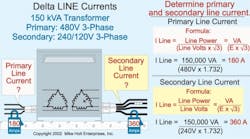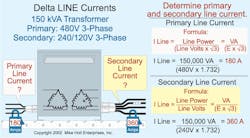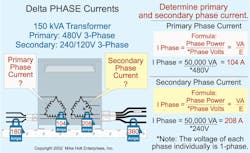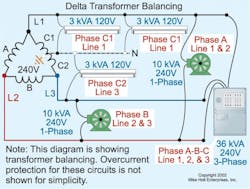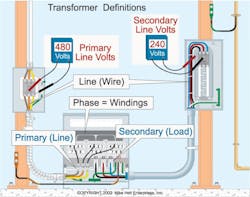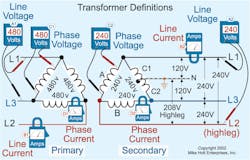Thank you for visiting one of our most popular classic articles. If you’d like to see updated information on this topic, please check out this recently published article, Transformer Calculations. |
Note: This article is based on the 2002 NEC.
Transformer configuration names like “delta” and “wye” derive from the way the windings are connected inside the transformer. These connections determine the way the transformer will behave, and they also determine the methods of calculation required for properly applying a given transformer.
Delta-connected transformers have the windings of three single-phase transformers connected in series with each other to form a closed circuit. The line conductors are connected to the unit where the two single-phase transformers meet. This configuration gets its name because in an electrical drawing it looks like a triangle (Greek symbol Δ for the letter “delta”). Many call it a high-leg system because the voltage from Line 2 to ground is higher than that of the other legs. For example, a 120V delta transformer will have a 208V leg.
Delta transformer current. In a delta transformer, the line current doesn't equal the phase current (as it does in a wye transformer). Because each line from a delta configured transformer is connected to two transformer phases, the line current from a 3-phase load will be greater than the phase current by the square root of 3. Note these formulas:
ILine= IPhase×√3
ILine= VALine÷(ELine × √3)
IPhase= ILine÷√3
IPhase= VAPhase÷EPhase
If you plug some numbers in, you can more clearly see the effects of the delta configuration on currents. Let's try this with a 240V, 36kVA, 3-phase load (Fig. 1 above).
First, let's solve for the line current (total line power=36kVA).
ILine=VALine÷(ELine×√3)
ILine=36,000VA÷(240V×√3)
ILine=87A
Now, let's solve for the phase current (phase power=12kVA, per winding).
IPhase=VAPhase÷EPhase
IPhase=12,000VA÷240V=50A
You can also find the line and phase currents using the other two formulas shown above.
ILine=IPhase×√3
ILine=50A × 1.732=87A
IPhase=ILine÷√3
IPhase=87A÷1.732=50A
We can also use the formula: ILine = VALine÷(ELine×√3). For example, what is the secondary line current for a 480V to 240/120V, 150kVA, 3-phase delta transformer (Fig. 2)? The answer is found as follows:
ILine=VALine÷(ELine×√3)
ILine=150,000VA÷(240V×1.732)= 360A
You can calculate the phase current of a delta transformer winding by dividing the phase VA by the phase volts: IPhase = VAPhase÷EPhase. The phase load in VA of a 3-phase, 240V load is the line load divided by three (one third of load on each winding). The phase load in VA of a single-phase 240V load is the line load (all on one winding). The phase load in VA of a single-phase, 120V load is the line load (all on one winding).
Let's look at another example problem. What is the secondary phase current for a 480V to 240/120V, 150kVA, 3-phase delta transformer (Fig. 3 above)?
Phase power=150,000VA÷3 per phase
Phase power=50,000VA per phase
IPhase=50,000VA÷240V
IPhase=208A
To better understand what happens in a delta system, try running these numbers with a 10A load and then with a 75A load.
Delta transformer balancing. To properly size a delta/delta transformer, the transformer phases (windings) must be balanced. You can do that with a two-step process:
Step 1. Determine the VA rating of all loads.
Step 2. Balance the loads on the transformer windings as follows:
-
3-phase loads: one-third of the load on each of the phases.
-
240V, single-phase loads: 100% of the load on Phase A or B. You can place some of the 240V, single-phase load on Phase C when necessary for balance.
-
120V loads: 100% of the load on C1 or C2.
To size the panelboard and its conductors, you must balance the loads in amperes. Why balance the panel in amperes? Why not take the VA per phase and divide by phase voltage? Because line current of a 3-phase load is calculated by the following formula:
ILine=VA÷(ELine×√3)
ILine=150,000VA÷(240V×1.732)= 208A per line.
If you took the per line power of 50,000VA and divided by one line voltage of 120V, you would come up with an incorrect line current of 50,000VA÷ 120V=417A.
Delta transformer sizing. Consider this method the next time you're sizing delta-connected transformers, where most of the loads are line-to-line. Once you balance the transformer, size it to the load of each phase. Size the “C” transformer using two times the highest of “C1” or “C2.” The “C” transformer is actually a single unit. If one side has a larger load, that side determines the transformer size.
Let's try another practice problem to reinforce these concepts. What size 480V to 240/120V transformer is required for the following loads: one 240V, 36kVA, 3-phase heat strip; two 240V, 10kVA, 3-phase loads; three 120V, 3kVA loads, single-phase (Fig. 4)?
(a) three single-phase, 25kVA transformers
(b) one 3-phase, 75kVA transformer
(c) a or b
(d) none of the above
Phase winding A=22kVA
Phase winding B=22kVA
Phase winding C=(12kVA of C1×2) = 24kVA
The answer is (c), a or b. You can use one single-phase 75kVA transformer or three 25kVA transformers for this load.
Now that you understand some transformer calculation basics and specifics on delta transformer calculations, you'll be able to size delta transformers correctly when the majority of the loads are line-to-line. You find delta-delta transformers most often in special applications. The most common configuration is the delta-wye. In the case of a delta-wye transformer, you now know how to size the primary side. After next month's article, which will address the wye transformer calculations, you'll be able to size any combination of delta and wye transformers.
Sidebar: Know Your Terms
To avoid confusion with transformer calculations, it's important to have a firm grasp of some basic concepts (Fig. 5 below). Once you're comfortable with these terms, you should be ready to tackle all types of transformer calculations.
Line — The ungrounded (hot) conductor(s).
Line current — The current on the ungrounded conductors (B1 and B2 in Fig. 6). In a delta system, the line current is greater than the phase current by the square root of 3, which is about 1.732). In a wye system, the line current equals the phase current.
Line voltage — The voltage between any two line (ungrounded) conductors (A1 and A2 in Fig. 6). In a delta system, the line voltage equals the phase voltage. But the delta system also has a high-leg.
Phase current — The current flowing through the transformer winding (D1 and D2 in Fig. 6). In a delta system, the phase current is less than the line current by the square root of 3. In a wye system, the phase current equals the line current.
Phase load — The load on the transformer winding.
Phase voltage — The internal transformer voltage generated across one winding of a transformer. For a delta secondary, the phase voltage equals the line voltage. In a wye system, the phase voltage is less than the line voltage by the square root of 3 (A2 and C2 in Fig. 6).
Ratio — The number of primary winding turns divided by the number of secondary winding turns.
Unbalanced load (neutral current) — The load on the secondary grounded (neutral) conductors.
